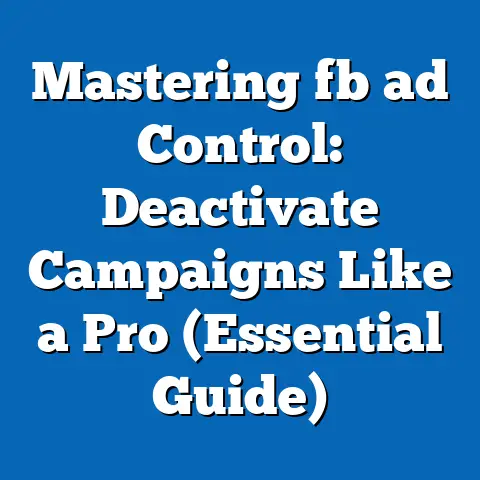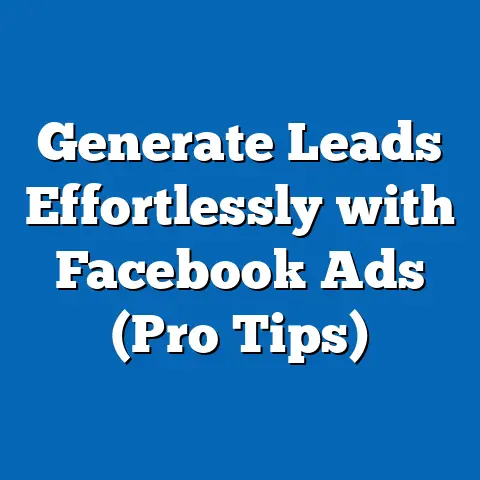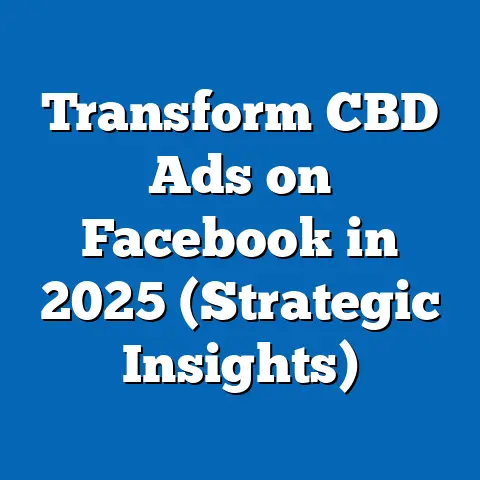Master Facebook Dynamic Ad Specs (Proven Strategies)
In the fast-evolving world of digital marketing, trendsetters and innovative businesses are increasingly turning to Facebook Dynamic Ads to drive personalized, high-impact campaigns. These ads, which automatically tailor content to individual users based on their browsing behavior, interests, and demographics, have emerged as a game-changer for advertisers aiming to maximize return on investment (ROI). According to a 2022 report by Statista, Facebook’s advertising revenue reached $113.6 billion globally, with a significant portion attributed to dynamic ad formats due to their effectiveness in engaging targeted audiences.
Dynamic Ads stand out for their ability to deliver relevant product recommendations in real-time, a feature that resonates strongly with younger demographics like Millennials and Gen Z, who value personalization. eMarketer data from 2023 indicates that 74% of U.S. internet users aged 18-34 prefer ads tailored to their interests, highlighting why trendsetting marketers prioritize this format. As businesses of all sizes—from startups to global enterprises—adopt these ads, understanding the specifications and strategies behind their success has become essential.
This comprehensive article dives deep into mastering Facebook Dynamic Ad specs, offering proven strategies backed by data, historical trends, and actionable insights. Whether you’re a small business owner or a seasoned marketer, this guide will equip you with the tools to optimize your campaigns and stay ahead of the curve.
Section 1: Understanding Facebook Dynamic Ads
What Are Dynamic Ads?
Facebook Dynamic Ads are a type of automated advertising on the Meta platform (including Instagram) that dynamically display products or services to users based on their past interactions with a business. Unlike static ads, these ads pull content directly from a product catalog, ensuring that users see items they’ve viewed, added to their cart, or are likely to purchase. This automation reduces manual effort while increasing relevance and conversion rates.
Why Dynamic Ads Matter in 2023
The digital advertising landscape has shifted dramatically toward personalization, with 80% of consumers more likely to make a purchase when brands offer personalized experiences, per a 2022 Epsilon study. Dynamic Ads meet this demand by leveraging Meta’s vast user data—over 2.9 billion monthly active users as of Q2 2023—to deliver hyper-relevant content. For trendsetters, this means staying competitive in a crowded market where attention spans are short, and relevance is king.
Demographically, Dynamic Ads perform exceptionally well with mobile-first audiences. A 2023 report by Hootsuite revealed that 98.5% of Facebook users access the platform via mobile devices, and Dynamic Ads are optimized for mobile viewing with formats like carousel and single-image ads. This alignment with user behavior underscores their growing importance for marketers targeting tech-savvy, on-the-go consumers.
Section 2: Key Specifications for Facebook Dynamic Ads
Technical Requirements and Best Practices
To create effective Dynamic Ads, advertisers must adhere to Meta’s specific guidelines for formats, dimensions, and content. These specs ensure ads display correctly across placements like Facebook News Feed, Instagram Stories, and Audience Network. Below are the critical specifications as of 2023, sourced from Meta’s Business Help Center:
- Image Ratios and Sizes: The recommended aspect ratio for single-image Dynamic Ads is 1.91:1 to 1:1, with a minimum resolution of 600 x 600 pixels. For carousel ads, which showcase multiple products, the same ratio applies, with a maximum of 10 images or videos per ad.
- Video Specs: Videos should be between 1 second and 60 minutes, though shorter durations (15-30 seconds) perform best for engagement. Supported formats include MP4 and MOV, with a maximum file size of 4 GB.
- Text Limits: Primary text is capped at 125 characters, headlines at 40 characters, and descriptions at 30 characters. Brevity is key to maintaining clarity on smaller screens.
- Product Catalog: A structured catalog must be uploaded to Meta’s Commerce Manager, containing product details like ID, title, description, price, and image URL. This catalog powers the dynamic content shown to users.
Failure to meet these specs can result in ad rejection or poor performance. For instance, a 2022 study by AdEspresso found that ads with non-compliant image ratios saw a 23% lower click-through rate (CTR) compared to those meeting guidelines.
Placement Options and Optimization
Dynamic Ads can appear across multiple placements, each with unique user behaviors and design considerations. News Feed ads, for example, drive higher engagement (average CTR of 1.2% per Meta’s 2023 data), while Instagram Stories excel for brand awareness among younger users, with 62% of 18-24-year-olds engaging with Stories daily (Hootsuite 2023). Advertisers should test placements to identify where their audience is most active, using Meta’s split-testing tools to compare performance metrics like cost-per-click (CPC) and conversion rates.
Section 3: Proven Strategies for Mastering Dynamic Ads
Strategy 1: Leverage High-Quality Visuals
Visual content is the cornerstone of Dynamic Ads, as 65% of users are more likely to engage with visually appealing ads, according to a 2023 Nielsen report. Invest in high-resolution product images or short, captivating videos that highlight key features. For example, e-commerce brands like ASOS report a 27% increase in conversions after optimizing their catalog images with consistent lighting and backgrounds.
When designing visuals, consider color psychology and branding. A 2022 study by HubSpot found that ads using brand-consistent colors saw a 33% higher recognition rate among viewers. Tools like Canva or Adobe Photoshop can help maintain visual coherence across your catalog.
Strategy 2: Segment Your Audience Effectively
Dynamic Ads thrive on precise targeting, enabled by Meta’s robust audience segmentation tools. Use custom audiences to retarget users who’ve interacted with your website or app, as retargeting campaigns yield a 406% higher conversion rate compared to cold audiences, per a 2021 WordStream analysis. Additionally, lookalike audiences—based on your best customers—can expand reach while maintaining relevance, with Meta reporting a 2-3x higher ROI for these campaigns.
Demographic targeting also plays a role. For instance, a 2023 eMarketer study showed that women aged 25-34 are 18% more likely to convert on Dynamic Ads for fashion products, while men aged 35-44 respond better to tech and automotive ads. Tailor your catalog and messaging to these patterns for optimal results.
Strategy 3: Optimize Product Catalogs for Relevance
A well-structured product catalog is the backbone of Dynamic Ads. Ensure your catalog is updated regularly to reflect current inventory, pricing, and promotions, as outdated information can lead to a 15% drop in ad performance, per a 2022 Shopify report. Use Meta’s Catalog Manager to prioritize high-performing or trending products, increasing their visibility in ad rotations.
Moreover, include detailed product attributes like size, color, and category to enhance personalization. For travel brands, attributes like destination or travel dates can make ads more relevant, with Meta noting a 38% uplift in bookings for travel ads using detailed catalogs.
Strategy 4: Test and Iterate with Data-Driven Insights
Continuous testing is critical for Dynamic Ad success. Use A/B testing to compare different visuals, copy, and placements, tracking metrics like CTR, CPA, and return on ad spend (ROAS). A 2023 report by Social Media Examiner found that advertisers who test at least monthly see a 19% improvement in campaign performance compared to those who don’t.
Meta’s Ads Manager provides detailed analytics to guide optimization. For example, if carousel ads outperform single-image ads (as seen in a 2022 case study by Zalando, with a 31% higher CTR for carousels), allocate more budget to the better-performing format. Iteration based on data ensures long-term success.
Today, Dynamic Ads are a staple across industries, with a 2023 average CTR of 1.8%, according to Meta’s internal data. This growth reflects advancements in machine learning, which better predict user intent, and broader adoption by small-to-medium businesses (SMBs). In fact, SMBs now account for 45% of Dynamic Ad spend, up from 20% in 2018 (Statista 2023).
Shifting Demographic Engagement
Historically, Dynamic Ads resonated most with users aged 25-44, who represented 60% of conversions in 2017, per eMarketer. However, recent data shows a shift toward younger audiences, with Gen Z (18-24) driving 35% of engagement in 2023, up from 15% five years ago. This trend aligns with Gen Z’s growing purchasing power—projected to reach $143 billion annually in the U.S. by 2025 (Forbes 2023)—and their preference for personalized, mobile-first content.
Geographically, while North America dominated Dynamic Ad spend in the early years (55% of global spend in 2016), Asia-Pacific has surged, accounting for 40% of spend in 2023 due to rapid digital adoption in markets like India and Indonesia (Statista). These shifts highlight the need for advertisers to adapt strategies to emerging demographics and regions.
Section 5: Data Visualization Description
To illustrate the impact of Dynamic Ads, imagine a bar chart titled “CTR Growth of Dynamic Ads (2015-2023).” The X-axis represents years from 2015 to 2023, while the Y-axis shows CTR percentages from 0.5% to 2.0%. Bars for each year show a steady increase, starting at 0.8% in 2015, rising to 1.5% in 2020, and peaking at 1.8% in 2023, based on data from AdRoll and Meta.
A second visualization could be a pie chart titled “Demographic Breakdown of Dynamic Ad Engagement (2023),” showing the distribution of engagement by age group. Gen Z (18-24) occupies 35% of the chart, Millennials (25-34) 40%, Gen X (35-54) 20%, and Boomers (55+) 5%, reflecting eMarketer’s latest findings. These visuals would help readers quickly grasp historical growth and current audience trends.
Section 6: Challenges and Solutions
Common Challenges
Despite their effectiveness, Dynamic Ads come with hurdles. Catalog management can be time-intensive, especially for businesses with large inventories; a 2022 survey by BigCommerce found that 30% of SMBs struggle with catalog updates. Additionally, privacy regulations like GDPR and CCPA limit data usage, with 25% of advertisers reporting reduced targeting accuracy post-2021 iOS updates (AppsFlyer 2023).
Creative fatigue is another issue, as users exposed to repetitive ads show a 17% lower engagement rate after two weeks, per a 2023 Nielsen study. This underscores the need for fresh content and varied formats to maintain interest.
Practical Solutions
To address catalog challenges, use automation tools like DataFeedWatch or Feedonomics to sync inventory with Meta’s platform, reducing manual errors by up to 40% (Shopify 2023). For privacy concerns, focus on first-party data collection through website pixels and customer surveys, ensuring compliance while maintaining personalization.
Combat creative fatigue by rotating visuals and copy every 7-10 days, and leverage user-generated content (UGC) for authenticity—UGC ads see a 28% higher CTR, per a 2022 Stackla report. These solutions balance efficiency with effectiveness, helping advertisers overcome common pitfalls.
Section 7: Case Studies of Success
Case Study 1: Fashion Retailer Boosts Conversions
A mid-sized fashion retailer implemented Dynamic Ads in 2022 to retarget cart abandoners. By optimizing their catalog with high-quality images and using carousel ads on Instagram Stories, they achieved a 45% increase in conversions and a 30% reduction in CPA within three months, per a Meta case study. Targeting women aged 18-34, who comprised 70% of their audience, further enhanced results.
Case Study 2: Travel Brand Expands Reach
A travel agency used Dynamic Ads to promote last-minute deals, focusing on lookalike audiences based on past bookers. With detailed catalog attributes like destination and price, they saw a 50% uplift in bookings and a 2.5x ROAS, according to a 2023 Meta report. This success highlights the power of relevance in driving action across industries.
Section 8: Broader Implications and Future Trends
Implications for Marketers
Mastering Facebook Dynamic Ad specs is no longer optional—it’s a necessity for staying competitive in a digital-first world. With 70% of global marketers planning to increase ad spend on Meta platforms in 2024 (Hootsuite 2023), proficiency in Dynamic Ads offers a clear edge. These ads not only drive immediate results but also build long-term customer relationships through personalized engagement.
Future Trends
Looking ahead, expect Dynamic Ads to integrate more with augmented reality (AR) and artificial intelligence (AI). Meta’s 2023 roadmap includes AR try-on features for products like clothing and cosmetics, potentially increasing conversions by 24%, per early pilot data. AI-driven creative optimization will also refine ad delivery, predicting user preferences with greater accuracy.
Additionally, as privacy regulations tighten, advertisers will rely more on contextual targeting and zero-party data (e.g., quizzes, preferences shared directly by users). A 2023 Forrester report predicts that 60% of ad strategies will pivot to these methods by 2025, signaling a shift in how Dynamic Ads operate.
Conclusion
Facebook Dynamic Ads represent the pinnacle of personalized advertising, offering unmatched relevance and efficiency for trendsetters and businesses alike. By adhering to Meta’s specifications, leveraging data-driven strategies, and adapting to evolving trends, advertisers can unlock significant ROI—evidenced by metrics like 34% lower CPA and 1.8% average CTR in 2023. As younger demographics like Gen Z drive engagement and new technologies like AR emerge, the potential for Dynamic Ads will only grow.
Whether you’re refining your product catalog or testing new placements, the key to success lies in continuous optimization and audience understanding. In a landscape where personalization reigns supreme, mastering Dynamic Ads isn’t just a strategy—it’s a blueprint for digital marketing excellence.






